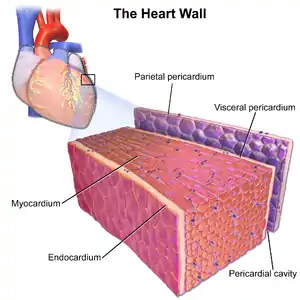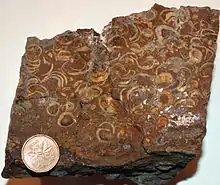Cardium
The term cardium comes from the Greek word for 'heart'. It is a frequently encountered term in physiology where it is incorporated into scientific nomenclature.

Human Heart
The wall of the human heart has three layers;
- Epicardium: the outer protective layer of the heart.
- Myocardium: muscular middle layer wall of the heart.
- Endocardium: the inner layer of the heart.
The entire protective region is oftentimes referred to as the cardium.[1] Endocarditis is an infection of the inner layer caused by the bacterium Bergeyella cardium.
Heart-Shaped Shells
._Etchi_Wellcome_V0021999.jpg.webp)
Cardium became the name of a taxonomic genus within the family Cardiidae – the cockles because of the heart-like appearance of its shells.[2] Their shells are widely used in cardium pottery as a decorative style imprint.
Shale Oil

*The Cardium Formation gets its name from marine clastic cardium shells that got deposited and fossilized during the late Cretaceous period. This region has become a major shale oil deposit shared by Alberta, British Columbia and Montana.[3]
References
- "The 3 Layers of the Heart Wall". Retrieved May 11, 2019.
- "Little Heart Cockle Corculum cardissa". Retrieved April 16, 2020.
- "cardium microseismic alberta A case history". Retrieved April 15, 2020.